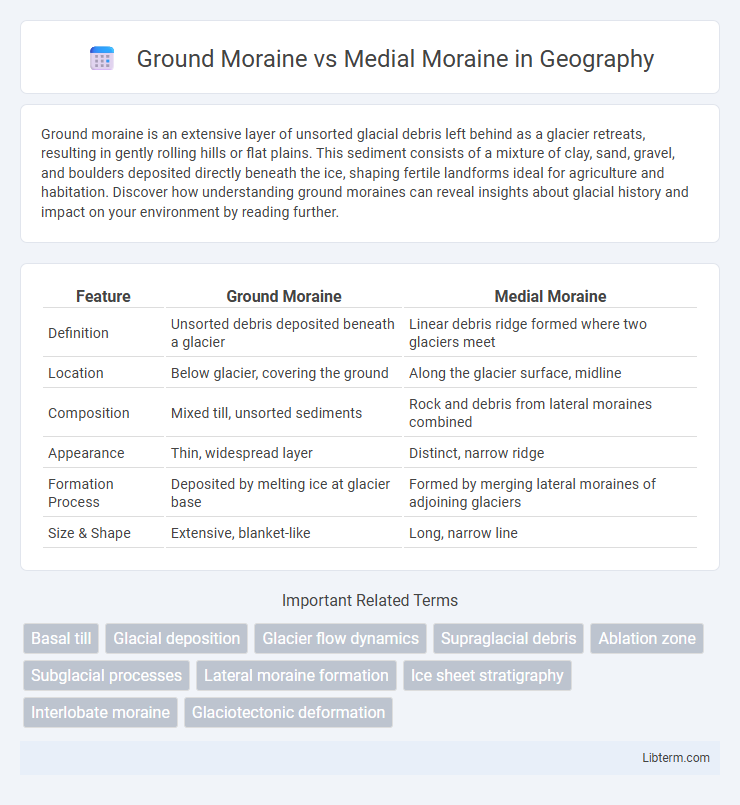Ground moraine is an extensive layer of unsorted glacial debris left behind as a glacier retreats, resulting in gently rolling hills or flat plains. This sediment consists of a mixture of clay, sand, gravel, and boulders deposited directly beneath the ice, shaping fertile landforms ideal for agriculture and habitation. Discover how understanding ground moraines can reveal insights about glacial history and impact on your environment by reading further.
Table of Comparison
| Feature | Ground Moraine | Medial Moraine |
|---|---|---|
| Definition | Unsorted debris deposited beneath a glacier | Linear debris ridge formed where two glaciers meet |
| Location | Below glacier, covering the ground | Along the glacier surface, midline |
| Composition | Mixed till, unsorted sediments | Rock and debris from lateral moraines combined |
| Appearance | Thin, widespread layer | Distinct, narrow ridge |
| Formation Process | Deposited by melting ice at glacier base | Formed by merging lateral moraines of adjoining glaciers |
| Size & Shape | Extensive, blanket-like | Long, narrow line |
Introduction to Ground and Medial Moraines
Ground moraines consist of unsorted glacial debris deposited directly beneath a glacier, forming a continuous blanket of till that shapes the underlying landscape. Medial moraines form when lateral moraines from two merging glaciers combine, creating linear ridges of debris running down the glacier's center. Both types of moraines provide crucial insights into glacier movement and sediment transport processes.
Definition of Ground Moraine
Ground moraine refers to an extensive, gently undulating layer of unsorted glacial till deposited beneath a glacier as it retreats, forming a broad blanket of sediment across the landscape. In contrast, medial moraine consists of linear ridges of debris formed where two glaciers converge, accumulating sediment along their merging ice streams. Ground moraine primarily influences the overall topography with its widespread sediment distribution, while medial moraine creates distinct narrow features on glacier surfaces and downstream deposits.
Definition of Medial Moraine
A medial moraine is a ridge of debris formed when two glaciers merge and their lateral moraines combine along the center of the resultant glacier. Ground moraine consists of unsorted sediment deposited beneath a glacier as it retreats, creating a blanket of till on the landscape. Medial moraines are significant for indicating glacier flow patterns, while ground moraines shape the basal terrain.
Formation Processes of Ground Moraine
Ground moraine forms through the deposition of unsorted sediment directly beneath a glacier as it melts, resulting in a widespread, gently rolling landscape of till. This sediment accumulation occurs when the ice surface lowers, releasing debris previously entrained at the glacier's base. In contrast, medial moraine develops from debris merging between two glacier ice streams, creating distinct linear ridges along the glacier's center line.
Formation Processes of Medial Moraine
Medial moraines form when two glaciers merge, causing lateral moraines from each glacier to combine and create a ridge of debris in the middle of the new glacier. This debris comprises rock, soil, and sediment transported along the glacier's interior, marking zones where ice masses converge. Ground moraines, in contrast, result from the widespread deposition of till beneath a glacier, creating a more uniform layer rather than linear ridges.
Key Differences Between Ground and Medial Moraine
Ground moraine forms as a continuous layer of unsorted debris deposited beneath a glacier, creating gently rolling hills when the ice melts. Medial moraine develops as a linear ridge of debris carried along the center of a glacier, formed where two glaciers merge and their lateral moraines join. Key differences include their location--ground moraine lies beneath the glacier, while medial moraine is found on the glacier surface--and their distinct deposition patterns, with ground moraine creating broad, uneven terrain and medial moraine producing narrow, elongated ridges.
Geographic Occurrence and Distribution
Ground moraines predominantly occur beneath continental glaciers and ice sheets, forming extensive, gently rolling landscapes across regions like the Midwest United States and parts of Canada. Medial moraines are commonly found in alpine glacial environments, where two glaciers merge, creating long, linear debris ridges visible in mountain ranges such as the Rockies and the Himalayas. The geographic distribution reflects the differing glacier dynamics: ground moraines span broad, low-relief areas, while medial moraines are confined to valley glaciers in rugged, high-relief terrains.
Visual and Physical Characteristics
Ground moraines form a continuous layer of till with a relatively flat, gently rolling surface composed of unsorted sediment deposited beneath a glacier. Medial moraines consist of linear ridges of debris located on the glacier surface, formed where two glaciers merge and their lateral moraines combine, creating a distinct dark stripe down the center. Visually, ground moraines appear as broad, hummocky plains often covered with vegetation, while medial moraines stand out as narrow, elevated bands of rocky material contrasting sharply with the surrounding ice.
Importance in Glacial Landscapes
Ground moraines consist of unsorted sediment deposited directly beneath glaciers, forming extensive, gently rolling terrains crucial for soil development and vegetation growth in glacial landscapes. Medial moraines form as distinctive ridges of debris along the center of merging glaciers, serving as key indicators of ice flow patterns and glacier dynamics. Understanding both types aids in reconstructing past glacial movements and predicting landscape evolution in formerly glaciated regions.
Summary: Ground Moraine vs Medial Moraine
Ground moraine consists of unsorted glacial debris deposited directly beneath a glacier, forming a continuous layer of sediment. Medial moraine forms when lateral moraines from two merging glaciers combine, creating a distinct ridge of debris running down the center of the resulting glacier. Both features reflect different processes of glacial sediment transport and deposition, with ground moraine representing basal till and medial moraine indicating the fusion of glacier debris along ice flow paths.
Ground Moraine Infographic

 libterm.com
libterm.com